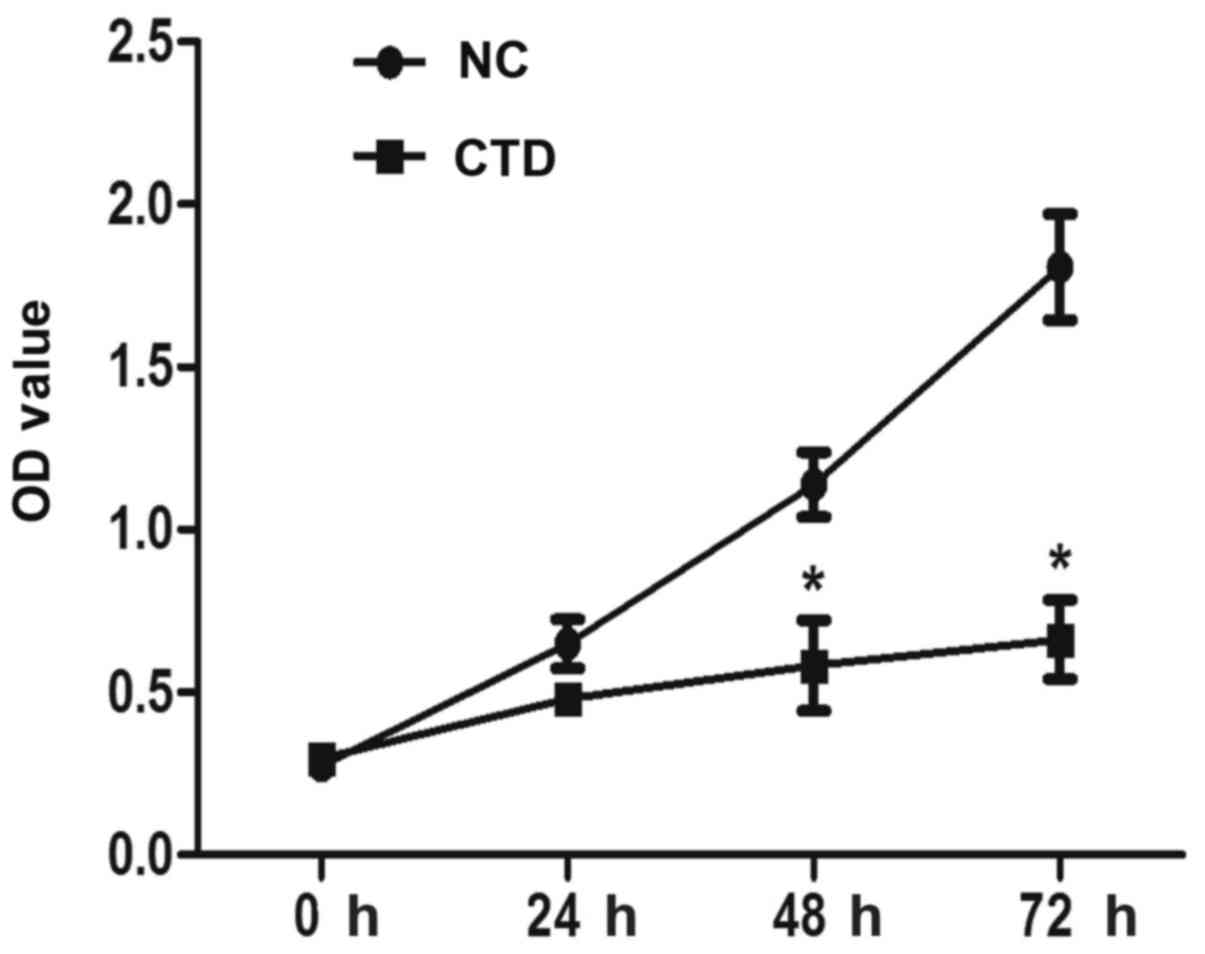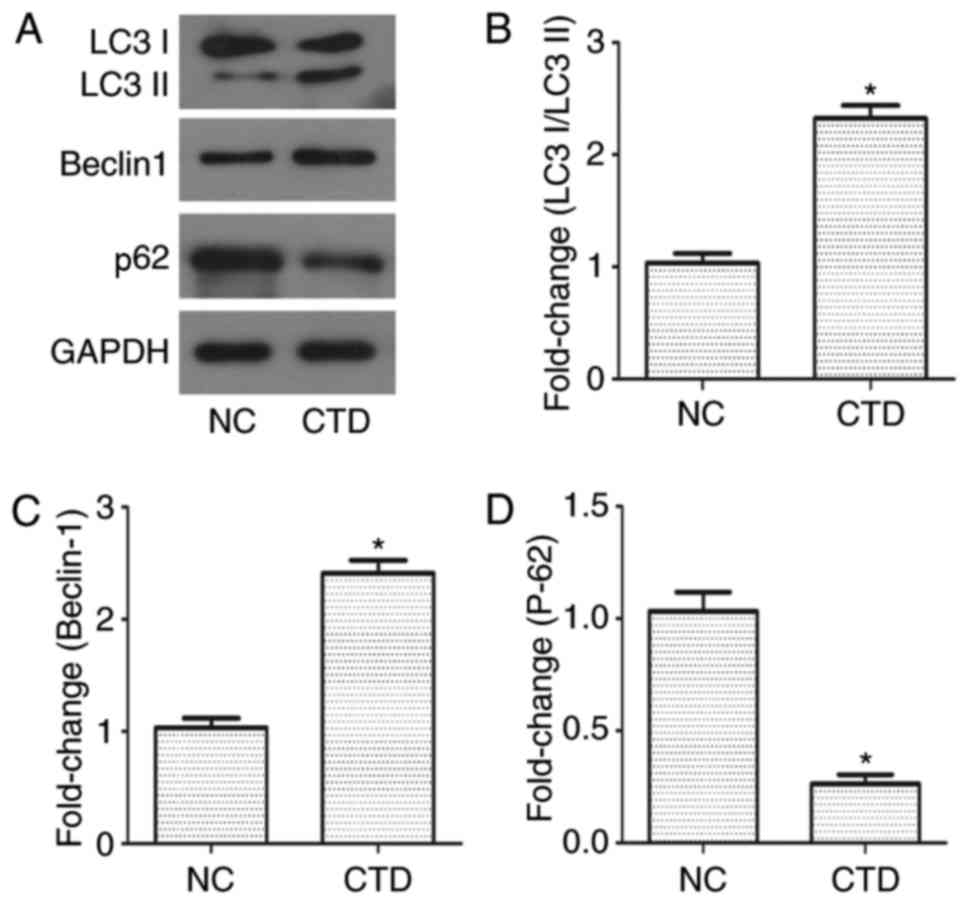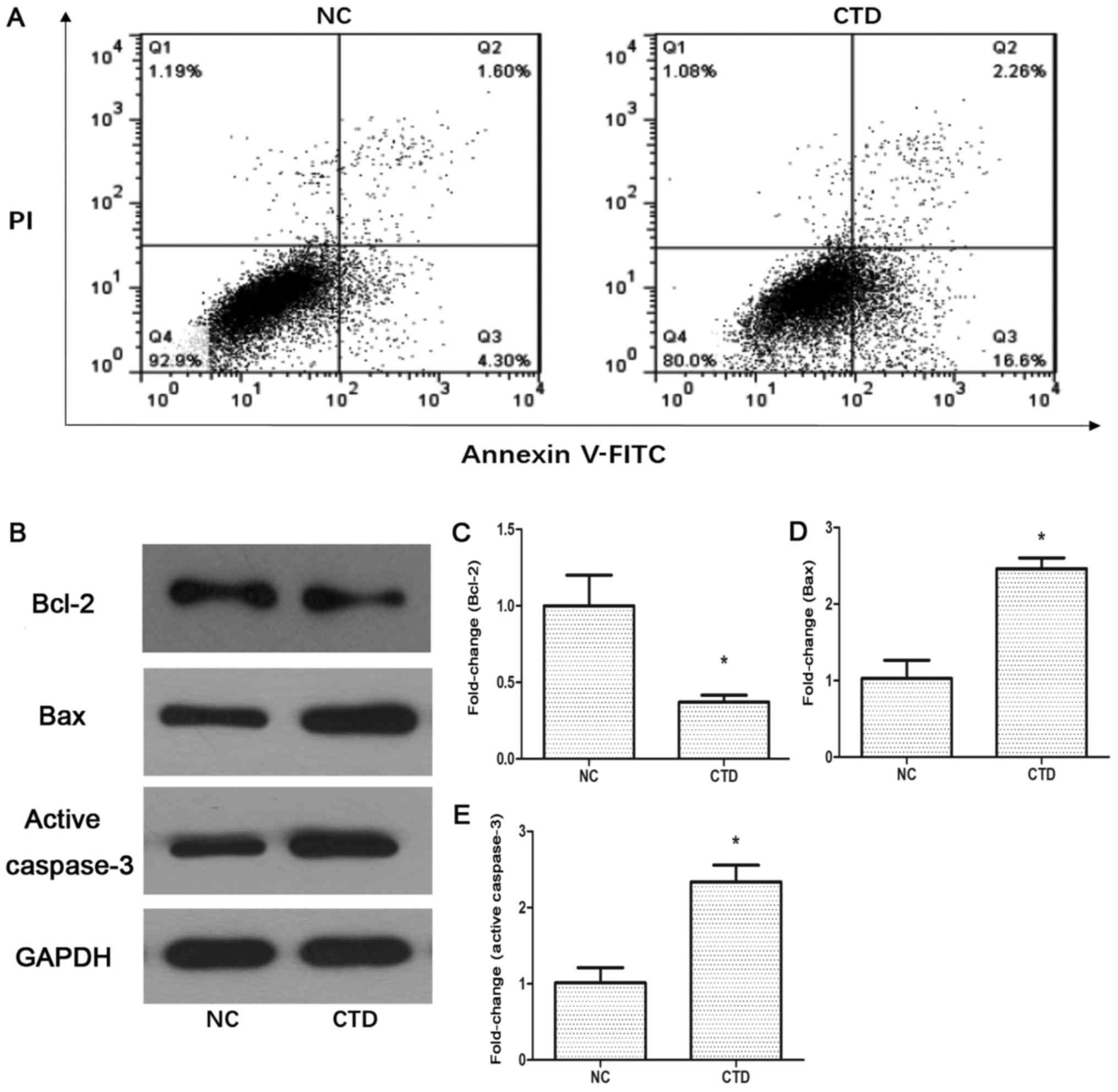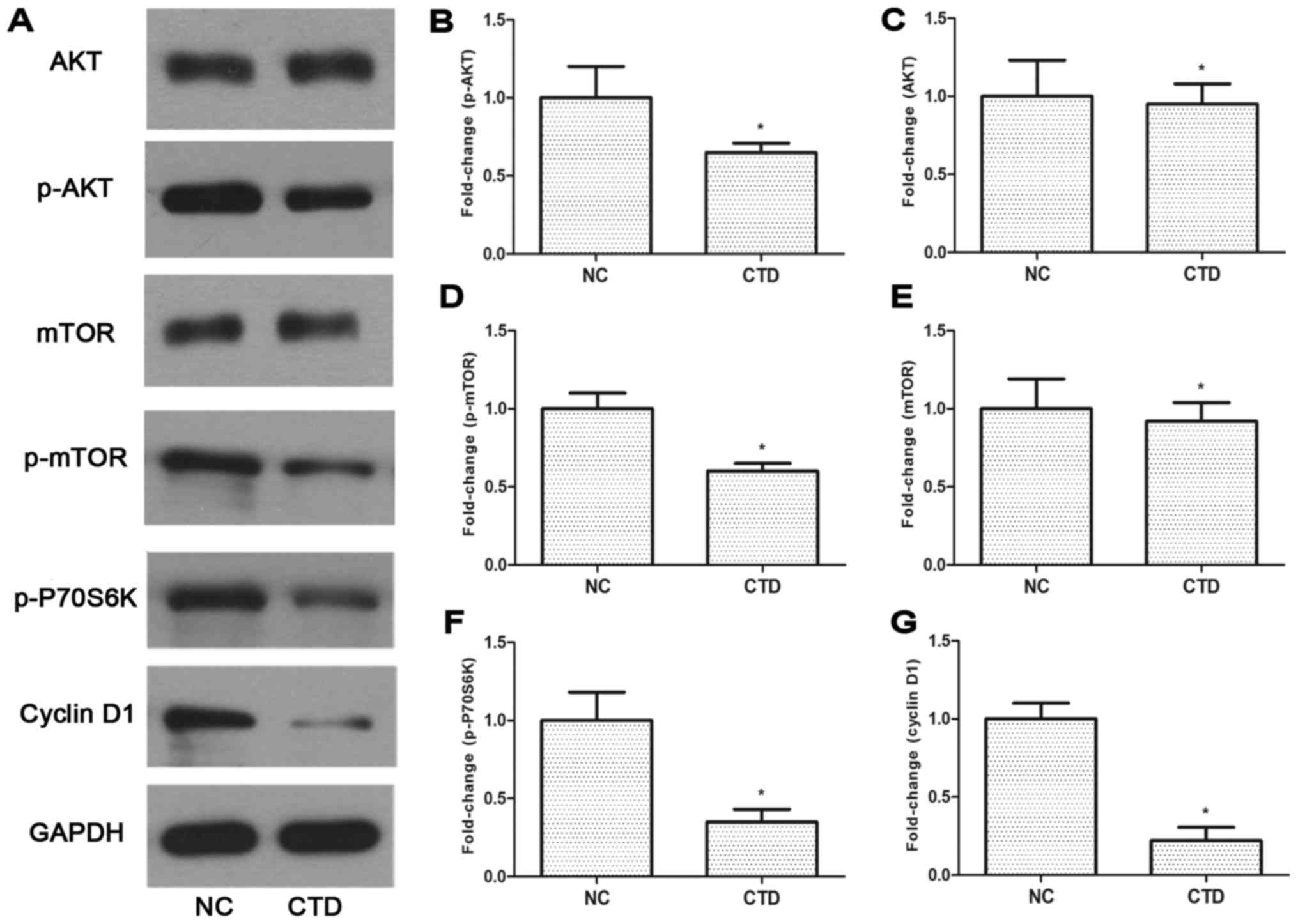Cantharidin suppresses cell growth and migration, and activates autophagy in human non-small cell lung cancer cells
- Authors:
- Published online on: March 1, 2018 https://doi.org/10.3892/ol.2018.8141
- Pages: 6527-6532
Abstract
Introduction
Lung cancer is a malignant type of cancer with a high incidence rate in China; it is primarily classified into two groups, small cell lung carcinoma and non-small cell lung carcinoma (NSCLC). Approximately 80% of patients with lung cancer have NSCLC (1,2), furthermore, >50% of these patients present with advanced local invasion and distant metastasis (3). Although chemotherapy is the principal treatment modality for the majority of patients, it is associated with a series of detrimental side effects, including suppression of the medulla oblongata, impaired immune function and toxicity in other organs (4–6). Therefore, improved therapeutic strategies and novel drug targets for NSCLC are required.
Autophagy is an important catabolic cellular homeostatic process; its mechanism involves the degradation of abnormal or dysfunctional cellular components resulting from digestion in lysosomes, which is associated with survival, differentiation and development in the normal physiology of cells (7). A number of studies have previously reported that autophagy exerts dynamic effects, including the promotion of apoptosis and the inhibition of proliferation in tumor cells (8–10). During the initiation of autophagy, Beclin-1 is able to promote LC3 to convert it to LC3-II, which is recruited to the major markers closely associated with autophagy are LC3 and p62. P62 binds to autophagosomal membrane and has been widely used as a protein marker to indicate the occurrence of autophagy. Two LC3 via the LC3 interacting region domain and is then degraded during the autophagy process. Thus, the conversion of LC3 I to LC3 II and clearance of p62 are considered hallmarks of the autophagic flux (11,12). However, the underlying molecular mechanisms of autophagy involved in cancer occurrence and development remain unresolved.
Therefore, drugs targeting autophagy may serve as a therapeutic strategy for patients with NSCLC. It has been reported that Cantharidin (CTD), an active chemical compound isolated from the blister beetle (Coleoptera: Meloidae), serves a notable role in promoting autophagy and suppressing hepatocellular carcinoma (13). Consequently, one aim of the present study was to investigate the association between CTD and autophagy. A further aim of present study was to characterize the antitumor effect of CTD, which mediated the inhibition of metastasis and growth by and its possible underlying mechanism in NSCLC using A549 cells.
Therefore, the present study aimed to investigate the effect of CTD on NSCLC cell proliferation and metastasis and explore the potential molecular mechanism, which may aid in identifying a novel agent for NSCLC therapy.
Materials and methods
Chemicals and antibodies
CTD was purchased from MedChemExpress (Monmouth Junction, NJ, USA). Primary antibodies against rabbit active caspase-3 (#9661), rabbit RAC serine/threonine-protein kinase (AKT; #9272), rabbit phosphorylated-(p-)AKT: (#9271), rabbit mechanistic target of rapamycin (mTOR; #2972), rabbit p-mTOR: (#2971), rabbit phosphorylated p-ribosomal p70S6 protein kinase (p-p70S6K; #9209) were purchased from Cell Signaling Technology, Inc. (Danvers, MA, USA). Primary antibodies against rabbit B cell lymphoma (Bcl)-2 (12789-1-AP), rabbit Bcl-2-associated X protein (Bax; 50599-2-Ig), mouse cyclin D1 (60186-1-Ig), rabbit Microtubule-associated protein 1A/1B-light chain 3 (LC3; 14600-1-AP), rabbit Beclin-1 (11306-1-AP), rabbit p62 (18420-1-AP), mouse GAPDH (60004-1-Ig), anti-rabbit (15134-1-AP) or anti-mouse (30000-0-AP) IgG-horseradish peroxidase-conjugated antibodies and the enhanced chemiluminescence (ECL) detection system were purchased from ProteinTech Group, Inc. (Wuhan, China).
Cell culture
The human lung cancer A549 cell line was purchased from the Institute of Biochemistry and Cell Biology (Shanghai, China) and were cultured at 37°C in 5% CO2 in RPMI-1640 medium supplemented with 10% FBS (both GE Healthcare Bio-Sciences, Pittsburgh, PA, USA), 100 U/ml penicillin G and 100 µg/ml streptomycin sulfate (Sigma-Aldrich; Merck KGaA, Darmstadt, Germany). Experiments were conducted with cells in the logarithmic growth phase (0.5–1×106 cells/ml). The experimental groups were treated with 1 µM CTD, which was in accordance with an effective minimum concentration as investigated by previous studies (14,15); the negative control group (NC) was cultured with 1% dimethyl sulfoxide (DMSO) culture media.
Cell proliferation assay
Cell proliferation was evaluated using the Cell Counting kit-8 (CCK-8) (Beijing Solarbio Science and Technology Co., Ltd., China) in accordance with the manufacturer's protocol. A total of 1×103 cells/well were seeded into 96-well plates for 24 h and then were incubated with CTD (1 µM) and a control group (1% DMSO in culture RPMI-1640 medium) for 24, 48 or 72 h. Absorbance (optical density) of viable cells was measured at a wavelength of 450 nm using a microplate reader (Bio-Rad Laboratories, Inc., Hercules, CA, USA).
Cell migration and invasion assay
Following treatment of cells with CTD for 48 h, cell migration and invasion were evaluated using 24-well transwell chambers (EMD Millipore, Billerica, MA, USA), in the presence (invasion assay) and absence (migration assay) of Matrigel matrix (BD Biosciences, Franklin Lakes, NJ, USA), according to the manufacturer's protocol. A total of 1×105 cells were resuspended in 100 µl serum-free RPMI-1640 medium and seeded in the upper chambers. The lower chambers were filled with 500 µl RPMI-1640 medium with 10% FBS (GE Healthcare Life Sciences, Shanghai, China). Following incubation at 37°C for 24 h, non-invading cells were removed using a cotton-tipped swab. The cells that permeated through the membrane to the bottom chamber were fixed at room temperature in 4% paraformaldehyde for 10 min and then stained with 0.5% crystal violet for 15 min at room temperature. The number of invaded or migrated cells was quantified by counting five random fields for each membrane under an inverted microscope (Olympus, Tokyo, Japan) with 10×20 magnification and the average number of cells per field was calculated.
Cell apoptosis analysis
An Annexin V-Fluorescein Isothiocyanate (FITC)/propidium iodide (PI) Apoptosis Detection kit (Beijing Chemclin Biotech Co. Ltd., Beijing, China) was used to detect apoptosis according to the manufacturer's protocol. Cells were incubated with 1 µM CTD at 37°C for 24 h and then changed to a culture with serum-free RPMI-1640 medium for 24 h and cells were harvested by trypsinization without EDTA (Invitrogen; Thermo Fisher Scientific, Inc., Waltham, MA, USA). Cells were resuspended in 1X binding buffer at 1–5×106 cells/ml. A total of 5 µl annexin V-FITC was added to 100 µl cell suspension and incubated in the dark for 5 min at room temperature. Following this, 10 µl PI and 500 µl PBS were added. The samples were then analyzed using a FACSCalibur cytometer (BD Biosciences) within 1 h. CellQuest Pro (version 5.1; BD Biosciences) was used for data analysis.
Western blot analysis
CTD groups and NC groups of A549 cells were incubated with their respective treatments for 24 h. Total protein was extracted from cells with radioimmunoprecipitation assay buffer (Cell Signaling Technology) containing protease and phosphatase inhibitor cocktails (Sigma-Aldrich; Merck KGaA) and the BCA Protein assay kit (Beijing ComWin Biotech Co., Ltd, Beijing, China) was used to determine the protein concentration. Equal quantities of proteins (20 µg) were separated by 8–12% SDS-PAGE and transferred to a polyvinylidene difluoride membrane (EMD Millipore) for immunoblotting analysis. Then, membranes were blocked with 5% non-fat milk at room temperature for 1.5 h. The membranes were subsequently incubated with primary antibodies against cyclin D1 (dilution 1:1,000), p-p70S6K (dilution 1:1,000 dilution), Bcl-2 (dilution 1:1,000), Bax (dilution 1:1,000), active caspase-3 (dilution 1:1,000), LC3 (dilution 1:1,000), Beclin-1 (dilution 1:1,000), p62 (dilution 1:1,000) and GAPDH (for reference; dilution 1:5,000) (ProteinTech Group, Inc., Wuhan, Sanying, China) at 4°C overnight followed by the aforementioned horseradish peroxidase-conjugated secondary antibodies (dilution 1:5,000) at room temperature in darkness for 2 h and developed with the aforementioned ECL method (ProteinTech Group, Inc.) in accordance with the manufacturers protocol. Densitometry analysis was performed using Image-Pro Plus 6.0 software (Media Cybernetics Inc. Rockville, MD, USA).
Statistical analysis
SPSS 22.0 (IBM Corp., Armonk, NY, USA) and GraphPad Prism 5 (GraphPad Software, Inc., La Jolla, CA, USA) were used to perform statistical analysis. Data are expressed as the mean ± standard deviation. The differences between the two groups were analyzed by Student's t-test. All experiments were performed in triplicate. P<0.05 was considered to indicate a statistically significant difference.
Results
CTD attenuates the growth, invasion and migration of A549 cells
The effect of CTD on proliferation of A549 cells was determined by CCK-8 assay. Results demonstrated that CTD significantly inhibited the proliferation of A549 cells at 48 and 72 h, following treatment with 1 µM CTD (Fig. 1, P<0.05).
To confirm the effect of CTD on the migration and invasion of A549 cells, transwell invasion and migration assays were conducted. As Fig. 2A depicts, the number of invading cells was significantly reduced following treatment with 1 µM CTD. The corresponding cell numbers for A549 cells were 86±6 and 29±2 in the NC and CTD groups, respectively (Fig. 2B, P<0.05), indicating the obstruction of invasive ability of A549 cells by CTD. A migration assay reveled similar results to the invasion assay, as the number of migrated A549 cells was also significantly suppressed following CTD treatment (18±5), when compared with the NC groups (32±2) (Fig. 2C and D; P<0.05).
CTD promotes A549 cell autophagy
To investigate whether there was an association between autophagy and the effects of CTD in A549 cells, western blotting was performed. The results demonstrated that there was a significant increase in the expression of LC3 I/LC3 II (<2.3-fold) and Beclin-1 (<2.5-fold), and a decrease in the expression of p62 in CTD-treated A549 cells (<0.3-fold), when compared with the control group (Fig. 3; P<0.05). These results indicated that autophagy may be involved in the inhibiting role of CTD in A549 cell migration and growth.
CTD induces A549 cell apoptosis
To demonstrate the role of CTD in apoptosis further, A549 cells were treated with 1 µM CTD and underwent flow cytometry analysis using annexin-V/PI. As demonstrated in Fig. 4A, the proportion of A549 cells undergoing apoptosis significantly increased in the CTD-treated group (18.8±0.5%) compared with the NC group (5.9±0.3%) (P<0.05). Western blot analysis was then used to detect any changes in the levels of apoptosis-associated proteins. The results demonstrated that the expression of Bcl-2 was significantly decreased (<0.4-fold) in the CTD-treated groups (Fig. 4B and C; P<0.05), whereas the expression level of Bax was upregulated (<2.5-fold; Fig. 4B and D; P<0.05). The level of active caspase-3, a paramount cleavage enzyme associated with the intrinsic and extrinsic apoptosis pathways, was also measured by western blotting. The results demonstrated that the expression level of active caspase-3 was increased (<2.2-fold) following CTD treatment (Fig. 4B and E; P<0.05). Taken together these results indicated that CTD may activate apoptotic pathways in A549 cells.
CTD inhibits activity of phosphatidylinositol 3-kinase (PI3K) signaling in A549 cells
Previous studies have demonstrated that the PI3K/Akt/mTOR pathway has a marked effect on tumor growth and survival (16,17). To confirm whether the PI3K/Akt/mTOR pathway was associated with the role of CTD in A549 cells, the present study examined the changes in the levels of total and p-Akt, and p-mTOR (Fig. 5A-E). The downstream factors p-p70S6K and cyclin D1 of the PI3K/Akt/mTOR pathway were also examined (Fig. 5F and 5G). Treatment with CTD led to the markedly decreased expression of p-Akt (<0.7-fold), p-mTOR (<0.6-fold), p-p70S6K (<0.3-fold) and cyclin D1 (<0.2-fold) levels in A549 cells (Fig 5B, D and G). These results demonstrated that CTD might inhibit the proliferation and metastasis of A549 cells via the PI3K/AKT/mTOR signaling pathway.
Discussion
In the present study, CTD was identified to significantly suppress the proliferation, migration and invasion of A549 cells. It was also observed that CTD may potentiate A549 cell autophagy and apoptosis. Furthermore, the present study provided evidence to indicate that CTD may exert its effects via inhibition of the PI3K/Akt/mTOR pathway.
Previous studies have reported that CTD efficiently inhibited proliferation and induced apoptosis in various cancer cells, including oral squamous cell carcinoma, renal carcinoma and gastric cancer cells (18–20). The results of the present study also demonstrated that CTD inhibited A549 cell proliferation and migration, which is consistent with the results of previous studies (18–20). The combined results of these studies provide evidence that CTD is a promising therapeutic candidate for the treatment of NSCLC.
A number of studies have reported that CTD exerted an inhibitory effect on cell proliferation by inducing apoptosis in a variety of tumor cells, including gastric, colorectal and pancreatic cancer cell lines (20–22). The results of the present study also demonstrated that CTD had a similar effect in promoting the apoptosis of NSCLC cells, by detecting levels of apoptotic markers, including anti-apoptosis protein Bcl-2 and pro-apoptosis proteins like Bax and active caspase-3. Based on the background that autophagy is a survival-promoting process that captures, degrades, and recycles intracellular constituents in lysosomes and is considered to serve a distinct role in the suppression of tumorigenesis and promotion of mortality (23,24), to investigate the underlying mechanism, autophagy markers were detected, namely, LC3, p62 and Beclin 1. The results revealed that CTD also exhibited an ability to induce autophagy. Previous studies have demonstrated that autophagy is able to accelerate the incidence of apoptosis and suppress tumor cell multiplication and growth (25,26), which is line with the present results. The pathways involved in autophagy progression are complicated. The PI3K/Akt/mTOR signaling pathway is closely associated with tumor growth and survival, was implicated to be involved in suppressing autophagy (26). It is established that PI3K is regarded as a key regulator in various essential cellular processes, including cell survival, growth, and differentiation. Once PI3K is activated, its catalytic subunit activates AKT by phosphorylating AKT and successively activates mTOR by phosphorylating mTOR. The activation of mTOR leads to phosphorylation of p70S6K1, a mediator of protein translation and cell growth (27–29). It has also been demonstrated that Cyclin D1, a PI3K/AKT pathway downstream factor, is associated with abnormal proliferation, invasion, and thus prognosis of cancer (30). In the present study, western blot analysis revealed that the PI3K/Akt/mTOR signaling pathway was inhibited in CTD-treated A549 cells, which may have enhanced autophagy in addition to its induction of apoptosis. However, there remained certain limitations of the study. Only one cell line and concentration of CTD were examined and no animal models were used. Future studies may focus on using an expanded variety of cell lines, or developing animal models.
In conclusion, the results of the present study indicate that CTD impeded cell growth and migration by promoting autophagy and apoptosis, which may be regulated by inhibiting the PI3K/Akt/mTOR signaling pathway in NSCLC. Therefore, this work provides a novel insight that CTD may serve as a potential candidate for development of a naturally derived antitumor agent.
References
|
Siegel R, DeSantis C, Virgo K, Stein K, Mariotto A, Smith T, Cooper D, Gansler T, Lerro C, Fedewa S, et al: Cancer treatment and survivorship statistics. CA Cancer J Clin. 64:220–241. 2012. View Article : Google Scholar | |
|
Blackhall F and Thatcher N: Chemotherapy for advanced lung cancer. Eur J Cancer. 40:2345–2348. 2004. View Article : Google Scholar : PubMed/NCBI | |
|
Grilli R, Oxman AD and Julian JA: Chemotherapy for advanced non-small-cell lung cancer: How much benefit is enough? J Clin Oncol. 11:1866–1872. 1993. View Article : Google Scholar : PubMed/NCBI | |
|
Iwamoto T: Clinical application of drug delivery systems in cancer chemotherapy: Review of the efficacy and side effects of approved drugs. Biol Pharm Bull. 36:715–718. 2013. View Article : Google Scholar : PubMed/NCBI | |
|
Olaussen KA and Postel-Vinay S: Predictors of chemotherapy efficacy in non-small-cell lung cancer: A challenging landscape. Ann Oncol. 27:2004–2016. 2016. View Article : Google Scholar : PubMed/NCBI | |
|
Yamamoto Y and Iwase H: [Management for treatment-induced adverse reaction-chemotherapy]. Nihon Rinsho. 70 Suppl 7:S672–S676. 2012. | |
|
Rabinowitz JD and White E: Autophagy and metabolism. Science. 330:1344–1348. 2010. View Article : Google Scholar : PubMed/NCBI | |
|
Duffy A, Le J, Sausville E and Emadi A: Autophagy modulation: A target for cancer treatment development. Cancer Chemother Pharmacol. 75:439–447. 2015. View Article : Google Scholar : PubMed/NCBI | |
|
Li C, Wang Y, Wang C, Yi X, Li M and He X: Anticancer activities of harmine by inducing a pro-death autophagy and apoptosis in human gastric cancer cells. Phytomedicine. 28:10–18. 2017. View Article : Google Scholar : PubMed/NCBI | |
|
Wang B, Lu D, Xuan M and Hu W: Antitumor effect of sunitinib in human prostate cancer cells functions via autophagy. Exp Ther Med. 13:1285–1294. 2017. View Article : Google Scholar : PubMed/NCBI | |
|
White E: The role for autophagy in cancer. J Clin Invest. 125:42–46. 2015. View Article : Google Scholar : PubMed/NCBI | |
|
Parzych KR and Klionsky DJ: An overview of autophagy: Morphology, mechanism, and regulation. Antioxid Redox Signal. 20:460–473. 2014. View Article : Google Scholar : PubMed/NCBI | |
|
Xiong X, Wu M, Zhang H, Li J, Lu B, Guo Y, Zhou T, Guo H, Peng R, Li X, et al: Atg5 siRNA inhibits autophagy and enhances norcantharidin-induced apoptosis in hepatocellular carcinoma. Int J Oncol. 47:1321–1328. 2015. View Article : Google Scholar : PubMed/NCBI | |
|
Kim YM, Ku MJ, Son YJ, Yun JM, Kim SH and Lee SY: Anti-metastatic effect of cantharidin in A549 human lung cancer cells. Arch Pharm Res. 36:479–484. 2013. View Article : Google Scholar : PubMed/NCBI | |
|
Zhang WD, Zhao HR, Yan Y, Wang XH, Zong ZH and Liu Y: Apoptosis induced by cantharidin in human pulmonary carcinoma cells A549 and its molecular mechanisms. Zhonghua Zhong Liu Za Zhi. 27:330–334. 2005.(In Chinese). PubMed/NCBI | |
|
Vanhaesebroeck B, Leevers SJ, Panayotou G and Waterfield MD: Phosphoinositide 3-kinases: A conserved family of signal transducers. Trends Biochem Sci. 22:267–272. 1997. View Article : Google Scholar : PubMed/NCBI | |
|
Pellegatta F, Chierchia SL and Zocchi MR: Functional association of platelet endothelial cell adhesion molecule-1 and phosphoinositide 3-kinase in human neutrophils. J Biol Chem. 273:27768–27771. 1998. View Article : Google Scholar : PubMed/NCBI | |
|
Ren Y, Zhang SW, Xie ZH, Xu XM, Chen LL, Lou ZG, Weng GB and Yao XP: Cantharidin induces G2/M arrest and triggers apoptosis in renal cell carcinoma. Mol Med Rep. 14:5614–5618. 2016. View Article : Google Scholar : PubMed/NCBI | |
|
Su CC, Lee KI, Chen MK, Kuo CY, Tang CH and Liu SH: Cantharidin induced oral squamous cell carcinoma cell apoptosis via the JNK-regulated mitochondria and endoplasmic reticulum stress-related signaling pathways. PLoS One. 11:e01680952016. View Article : Google Scholar : PubMed/NCBI | |
|
Zhang C, Chen Z, Zhou X, Xu W, Wang G, Tang X, Luo L, Tu J, Zhu Y, Hu W, et al: Cantharidin induces G2/M phase arrest and apoptosis in human gastric cancer SGC-7901 and BGC-823 cells. Oncol Lett. 8:2721–2726. 2014. View Article : Google Scholar : PubMed/NCBI | |
|
Liu B, Gao HC, Xu JW, Cao H, Fang XD, Gao HM and Qiao SX: Apoptosis of colorectal cancer UTC116 cells induced by Cantharidinate. Asian Pac J Cancer Prev. 13:3705–3708. 2012. View Article : Google Scholar : PubMed/NCBI | |
|
Li W, Xie L, Chen Z, Zhu Y, Sun Y, Miao Y, Xu Z and Han X: Cantharidin, a potent and selective PP2A inhibitor, induces an oxidative stress-independent growth inhibition of pancreatic cancer cells through G2/M cell-cycle arrest and apoptosis. Cancer Sci. 101:1226–1233. 2010. View Article : Google Scholar : PubMed/NCBI | |
|
Anding AL and Baehrecke EH: Autophagy in cell life and cell death. Curr Top Dev Biol. 114:67–91. 2015. View Article : Google Scholar : PubMed/NCBI | |
|
Denton D, Xu T and Kumar S: Autophagy as a pro-death pathway. Immunol Cell Biol. 93:35–42. 2015. View Article : Google Scholar : PubMed/NCBI | |
|
Wang YX, Xu SQ, Chen XH, Liu RS and Liang ZQ: Autophagy involvement in olanzapine-mediated cytotoxic effects in human glioma cells. Asian Pac J Cancer Prev. 15:8107–8113. 2014. View Article : Google Scholar : PubMed/NCBI | |
|
Mihalache CC, Yousefi S, Conus S, Villiger PM, Schneider EM and Simon HU: Inflammation-associated autophagy-related programmed necrotic death of human neutrophils characterized by organelle fusion events. J Immunol. 186:6532–6542. 2011. View Article : Google Scholar : PubMed/NCBI | |
|
Hassan B, Akcakanat A, Holder AM and Meric-Bernstam F: Targeting the PI3-kinase/Akt/mTOR signaling pathway. Surg Oncol Clin N Am. 22:641–664. 2013. View Article : Google Scholar : PubMed/NCBI | |
|
Sheppard K, Kinross KM, Solomon B, Pearson RB and Phillips WA: Targeting PI3 kinase/AKT/mTOR signaling in cancer. Crit Rev Oncog. 17:69–95. 2012. View Article : Google Scholar : PubMed/NCBI | |
|
Matsuoka T and Yashiro M: The role of PI3K/Akt/mTOR signaling in gastric carcinoma. Cancers (Basel). 6:1441–1463. 2014. View Article : Google Scholar : PubMed/NCBI | |
|
Alao JP: The regulation of cyclin D1 degradation: Roles in cancer development and the potential for therapeutic invention. Mol Cancer. 6:242007. View Article : Google Scholar : PubMed/NCBI |














